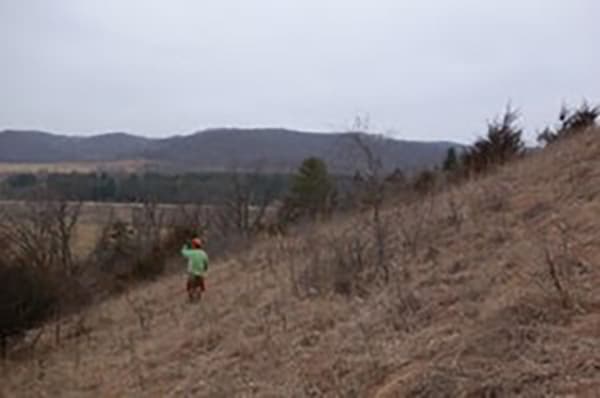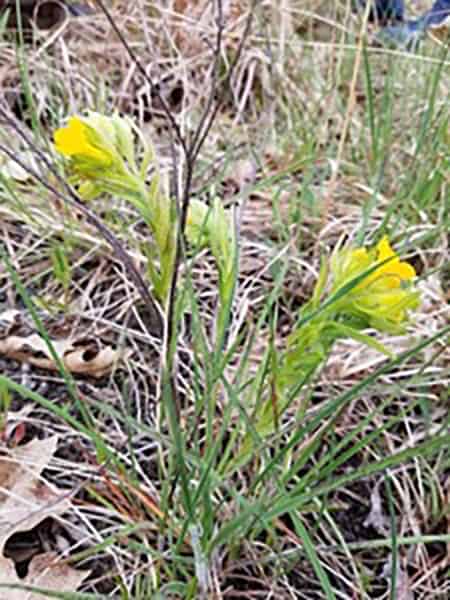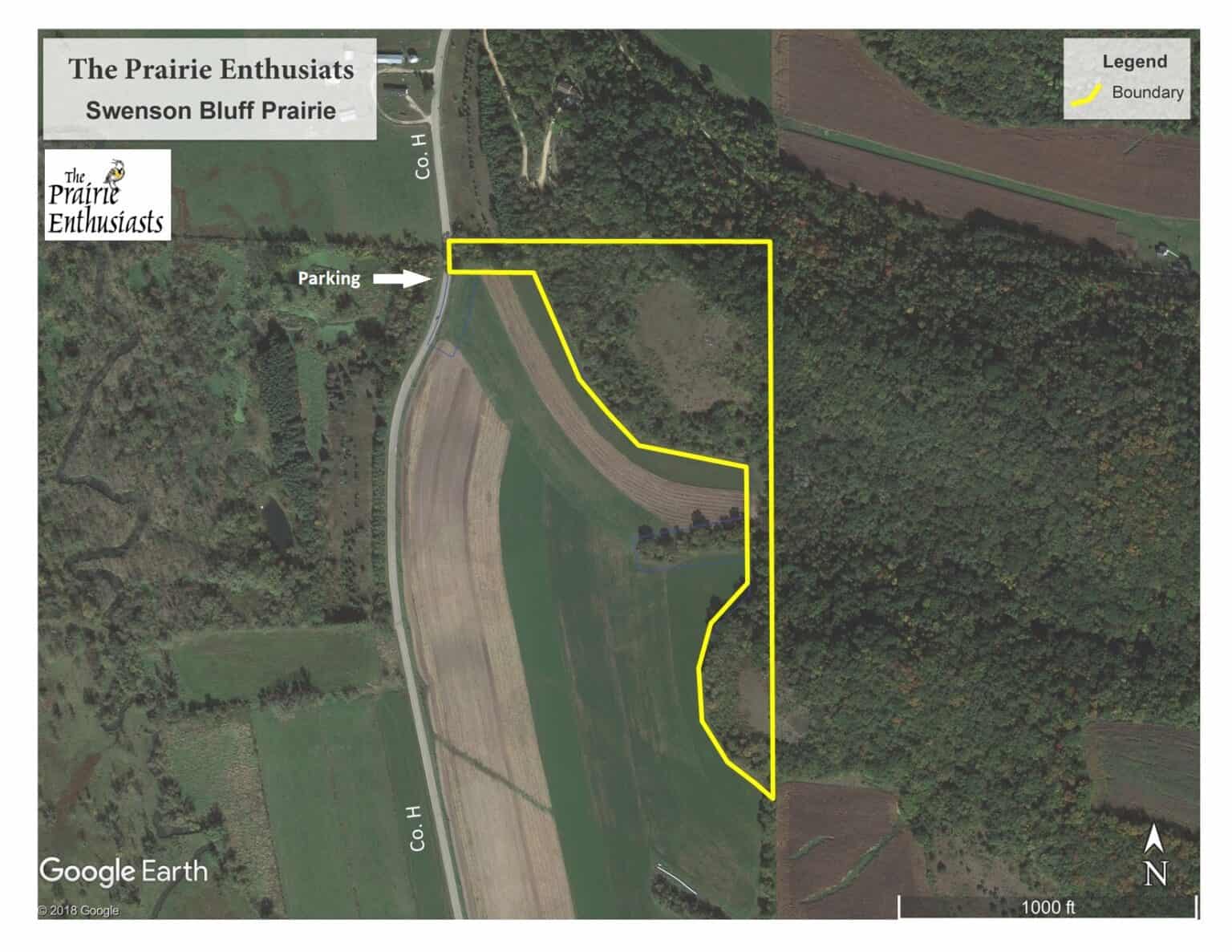
Swenson Bluff Prairie
The Swenson Bluff Prairie site contains two distinct non-contiguous prairie remnants sitting high atop the bluff, with spectacular views of the farms and St. John the Baptist Catholic Church situated in the wide, flat valley below. The larger of the two parcels, known as Swenson Hill Prairie, is approximately 16 acres, including the surrounding woods. At the top of the hill are five acres of open grassland, a large remnant representative of calcareous, dry-mesic hill prairie. Plant species present indicate a light or non-existent grazing history, and it is most notable for the heterogeneity of its summer prairie flora. The smaller parcel, known as Shooting Star Prairie, is approximately 3 acres in size. In addition to a huge display of its namesake plant, this small remnant is also home to the largest Wisconsin population of pale false foxglove (Agalinis skinneriana), a prairie annual listed as endangered or threatened in all states where it occurs.
ACCESS & DIRECTIONS
The larger parcel of this site is located 1.9 miles south of State Highway 14, and the village of Arena, on County Road H. There is no parking lot; park in the west roadside right-of-way of County Road H (to be legal, parked vehicles need to be at least 3 feet away from the gravel shoulder). Access is by foot only starting at the TPE sign, walking along the field edge to the trail head at the edge of the wooded area. The smaller parcel is located 0.2 miles to the south-southeast. The hike up to either prairie is very steep.
Google Map
Description & Significance

Swenson Hill Prairie is, at five acres of open grassland, a large remnant representative of calcareous, dry-mesic hill prairie. It is largely free of common herbaceous weeds such as white sweetclover (Melilotus alba) and wild parsnip (Pastinaca sa). There are small clusters of compass plant (Silphium laciniatum), indicating a light or non-existent grazing history (the hillside is considerably removed from the dairy barn on the Swenson farm). It is most notable for the heterogeneity of its summer prairie flora, with leadplant, butterflyweed, and prairie coreopsis (Amorpha canescens, Asclepias tuberosa, and Coreopsis palmata) blooming in a vast, intermixed display. Likewise, the 2014 burn revealed a rich display of prairie spring ephemerals (violets, puccoon, and violet wood sorrel among them) on a lower, more level portion of the property. Other plants of note are tuberous Indian plantain, prairie turnip, cream Baptisia, and Hill’s thistle (Arnoglossum plantagineum, Pediomelum esculentum, Baptisia bracteate, and Cirsium Hillii).
After extensive clearing in 2003, Shooting Star Prairie demonstrated why it received its common name. The skirt of brush at the base of the hill had concealed a huge display of Shooting Star (Dodecatheon meadia). This small remnant is also home to one of four, and the largest, Wisconsin populations of pale false foxglove, Agalinis skinneriana, a prairie annual that is listed as Endangered or Threatened in all the States where it occurs.
Good invertebrate records from WDNR surveys in the 1990s and 2000s exist for both parcels. Across both tracts, thirteen prairie-specialist species – those dependent on prairie remnants – have been cataloged. On Swenson Hill Prairie, there is a collection record for the rare Kansas Prairie Leafhopper (Prairiana kansana), but that collection was not repeated after the initial collection. The WDNR lists P. kansana as a Species of Greatest Conservation Need (SGCN). Shooting Star Prairie has rich sods of prairie dropseed (Sporobolus heterolepis) which harbor the State-endangered Hill Prairie Shovelhead Leafhopper (Attenuipyga vanuduzeei), known from only six or seven locations in the Upper Midwest. The State-threatened prairie specialist Net-Veined Leafhopper (Polyamia dilata is also found on Shooting Star Prairie.
SGCN, Threatened and Endangered Species on the Swenson Hill (SHP) and Shooting Star Prairies (SSP):
| SPECIES | COMMENTS |
| PLANTS | |
| Pale False Foxglove Agalinis skinneriana |
WI Endangered (S2) |
| Prairie Indian-plantain Arnoglossum plantagineum |
WI Special Concern (S3) |
| Hill’s Thistle Cirsium Hillii |
WI Threatened (S3) Federal Species of Concern (SOC) |
| Prairie Turnip Pediomelum esculentum |
WI Special Concern (S3) |
| INVERTEBRATES | |
| Hill Prairie Shovelhead Leafhopper Attenuipyga vanduzeei |
WI Endangered (S1) Federal Species of Concern (SOC) |
| Net-Veined Leafhopper Polyamia dilata |
WI Threatened (S2) |
| Kansas Prairie Leafhopper Prairiana kansana |
WI Special Concern (S2) Little Information |
Usage Policies
Allowed:
- Outdoor Recreation
- Hunting (for all species, no permit or reservation required)
Not Allowed:
Ownership History
The Prairie Enthusiasts have been active on the Swenson Bluff Prairie site with management activities and field trips since 2002. This, along with the ongoing relationship maintained with the Swenson family by volunteers Amy Staffen and Scott Sauer through the past decades, kept the protection prospects alive and led to TPE ownership on August 20, 2018. Funding for this purchase was made possible, in part, by the Wisconsin Department of Natural Resources Knowles-Nelson Stewardship Program.
The Swenson Bluff Prairie parcels are part of a larger prairie complex with other remnants persisting on nearby hillsides and bluff tops, making this an important area for native plant diversity. The Nature Conservancy (TNC) led protection efforts in this area beginning in the early 1990’s when TPE was still a small organization. The Nature Conservancy’s interest in this area derived primarily from the presence of the rare Agalinis skinneriana and, secondarily, from the biodiversity of the area provided by the prairie-savanna-woodland complex.
Either the Swenson Hill or nearby Drakenburg prairie were included in the description and analysis of dry-mesic prairies in John Curtis’s seminal work The Vegetation of Wisconsin (1956). Notes within the 1990 TNC description of the sites and the St. John’s Complex suggest that Olive Thomson visited these sites in the 1950’s. (Read more about Dr. John and Olive Thomson, premier conservationists, environmental education leaders and naturalists.)
Management
In 2002, with funding provided by a US Fish and Wildlife Service (USFWS) grant for private lands, both Swenson Hill Prairie and Shooting Start Prairie were largely cleared of invasive red cedars, as well as some planted and volunteer white pines, black cherry, buckthorn, honeysuckle, and other invasive shrubs. In 2007, TPE volunteers burned roughly 2/3 of Swenson Hill Prairie. Site steward Scott Sauer, along with volunteers from Quercus Land Stewardship, conducted winter-season burns on Swenson Hill Prairie in 2012, 2013, 2014 and 2016.
Current management efforts are focused on continued removal of invasive species, especially buckthorn and honeysuckle.

